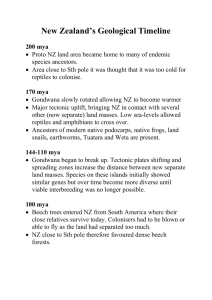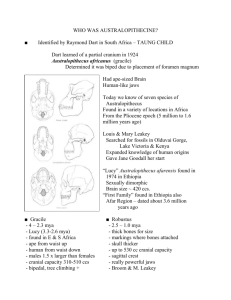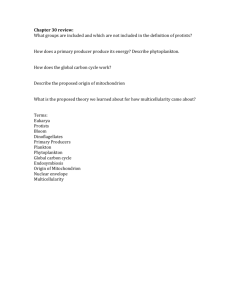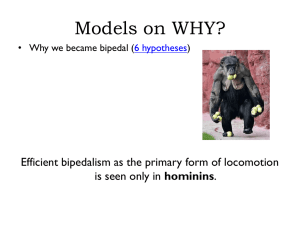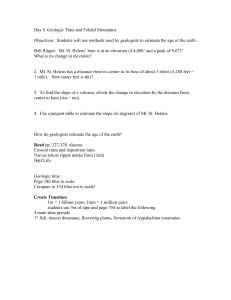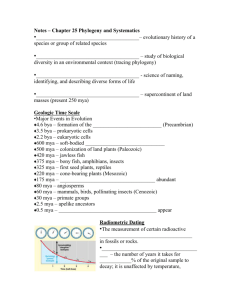Our Earliest Ancestors and Australopithecines 2-16 through 2-19
advertisement
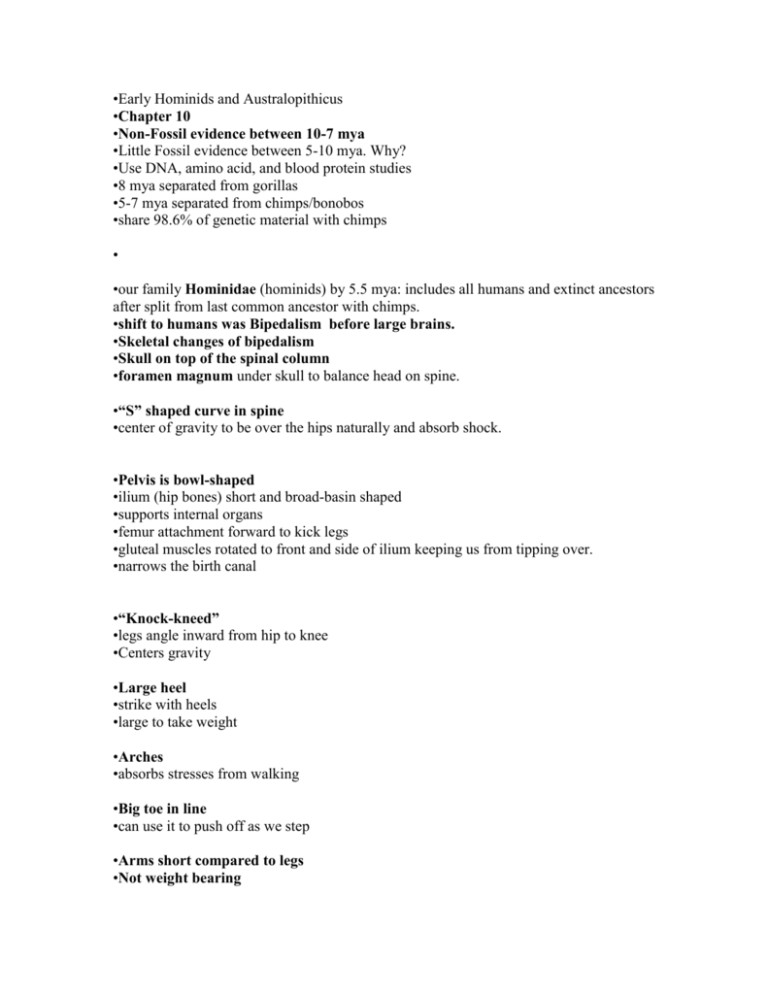
•Early Hominids and Australopithicus •Chapter 10 •Non-Fossil evidence between 10-7 mya •Little Fossil evidence between 5-10 mya. Why? •Use DNA, amino acid, and blood protein studies •8 mya separated from gorillas •5-7 mya separated from chimps/bonobos •share 98.6% of genetic material with chimps • •our family Hominidae (hominids) by 5.5 mya: includes all humans and extinct ancestors after split from last common ancestor with chimps. •shift to humans was Bipedalism before large brains. •Skeletal changes of bipedalism •Skull on top of the spinal column •foramen magnum under skull to balance head on spine. •“S” shaped curve in spine •center of gravity to be over the hips naturally and absorb shock. •Pelvis is bowl-shaped •ilium (hip bones) short and broad-basin shaped •supports internal organs •femur attachment forward to kick legs •gluteal muscles rotated to front and side of ilium keeping us from tipping over. •narrows the birth canal •“Knock-kneed” •legs angle inward from hip to knee •Centers gravity •Large heel •strike with heels •large to take weight •Arches •absorbs stresses from walking •Big toe in line •can use it to push off as we step •Arms short compared to legs •Not weight bearing •Theories on the Evolution of Bipedalism •Freeing hands •carrying food to different places •adaptive advantage in the savannah •efficiently move between scattered forests and grasslands •see prey and predators above the grass •More efficient for travel as compared to knuckle walkers. •More efficient regulating body temperature •top of the head is exposed =less surface area •higher off of ground •Radiator circulatory system: cool brain lHominid Characteristics •Bipedal •Dentition: •Parabolic arch- tooth row is rounded arch •anterior teeth small and posterior teeth larger •No diastema: space between canine and premolar for canine. •No CP3 honing complex •Smaller canine •Thick enamel •Cranial Features: •increase in brain and decrease in face size •Less prognathism: face juts out less lApe Phylogeny and the Human line •15 mya separated from orangutans •8 mya separated from gorillas •6 mya separated from chimps/bonobos Sahelanthropus tchadensis (“Sahara hominid from Chad”) •Age 7-6 mya •Chad, Africa •small ape-size brain (320-380 cc) •Hominid: anterior foramen magnum (possibly bipedal) •May or may not be hominid Orrorin tugenensis (“Millenium Man”) •Age 6 mya •Kenya at Tugen Hills •possibly bipedal •may or may not be hominid What were these early hominids like? •ate hard foods- nuts, seeds, fruit •lived in many habitats: ground and trees •climate shift •forest becoming separated by savanna •niche gave rise to bipedal locomotion Our Family Tree •Ardipithecus ramidus(Ardipithicus kadabba) •Age 4.4 mya •Afar Triangle, Ethiopia •Ancestor of Australopithecines and hominids? •Characteristics •ape-like teeth •Small molars, large canines •hominid-like body: biped •Foramen magnum position, arms not weight bearing •Position of big toe lArdipithecus ramidus The Australopithecines (“Southern Ape”) •the first definite hominids •General characteristics •4.2-1 mya •Eastern, Southern, Central Africa Features •Human like teeth: small canines, thick enameled molars, parabolic arch •bipedal : foramen magnum under skull, hip and knee morphology, curvature of spine, inline big toe •partly arboreal: long arms, long big toe •sexual dimorphism: males larger than females •Small brain 310-510 cc 2 groups: Gracile and Robust (8 species) •Adaptive Radiation of early hominids •dispersal and divergence related to different environments. •cohabitation of hominid species but occupied different food niches. lGracile Australopithecines (A. anamensis, A. afarensis, A. africanus, A. bahrelghazali, A. garhi) •fossil sites: •Laetoli, Ethiopia- Mary Leakey, Laetoli footprints •Hadar, Ethiopia- Donold Johanson, “Lucy”, A. afarensis •age: 4.2-2 mya Characteristics •small brain •thick enamel on molars and large canines •ate seeds and nuts •sexual dimorphism •Biped: pelvis, leg, foramen magnum lThe Dikika Baby, A. afarensis (3.3 MYA) •includes milk teeth and permanent teeth, an ape-like hyoid bone, and clear evidence of bipedal and arboreal traits. "Robust" Australopithecines •fossil sites: •Swartkranz, South Africa, Robert Broom •Oldavai Gorge, Tanzania by Mary and Louis Leakey •age: 2.7-1 mya Characteristics •large molars •Large face and jaws •sagittal crest •lower body like graciles •ate hard seeds, nuts, roots, twigs •evolutionary dead end because so specialized. •who shared habitats? •A. boisei and Homo in southern Africa •A, garhi and A. aethiopicus in eastern Africa, •And A. afarensis and K. platyops in eastern Africa •all had different dietary niches that allowed them to coexist.
